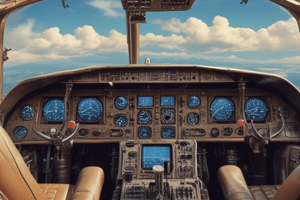Podcast
Questions and Answers
What is the primary purpose of an LED in an aircraft?
What is the primary purpose of an LED in an aircraft?
- To provide power to the aircraft's systems
- To indicate on/off conditions on panels (correct)
- To control the aircraft's temperature
- To detect infrared radiation
What is the typical operating voltage of an LED?
What is the typical operating voltage of an LED?
- 1.6 V forward bias (correct)
- 1.6 V reverse bias
- 10 V forward bias
- 20 V reverse bias
What is the function of the arrows in the standard diode symbol for an LED?
What is the function of the arrows in the standard diode symbol for an LED?
- Indicate the polarity of the LED
- Indicate the operating voltage of the LED
- Indicate the direction of current flow
- Indicate the direction of light emission (correct)
What is the expected life expectancy of an LED?
What is the expected life expectancy of an LED?
What is the purpose of the flat spot on the red plastic base of an LED?
What is the purpose of the flat spot on the red plastic base of an LED?
What will happen if an LED is connected to a power supply rated at over 2 V?
What will happen if an LED is connected to a power supply rated at over 2 V?
What is the typical current required by an LED?
What is the typical current required by an LED?
What type of light can be emitted by an LED?
What type of light can be emitted by an LED?
What happens when the second polarizer blocks the passage of light in an LCD?
What happens when the second polarizer blocks the passage of light in an LCD?
What is the primary difference between a backlit LCD and a normal-type LCD?
What is the primary difference between a backlit LCD and a normal-type LCD?
What is the function of the white diffusion panel in a backlit LCD?
What is the function of the white diffusion panel in a backlit LCD?
How many levels of brightness can most modern LCDs display per pixel?
How many levels of brightness can most modern LCDs display per pixel?
What is required to create a colour pixel in an LCD?
What is required to create a colour pixel in an LCD?
What determines the intensity of each sub-pixel in a colour LCD?
What determines the intensity of each sub-pixel in a colour LCD?
What is the result of varying the voltage applied to an LCD segment?
What is the result of varying the voltage applied to an LCD segment?
What is the purpose of controlling the voltage applied to an LCD segment?
What is the purpose of controlling the voltage applied to an LCD segment?
What allows the receiving end to perceive an image as a large number of simultaneously produced areas of illumination?
What allows the receiving end to perceive an image as a large number of simultaneously produced areas of illumination?
What is the method of transmitting photocell signals in rapid succession called?
What is the method of transmitting photocell signals in rapid succession called?
How are the connections to the scanning switch arranged?
How are the connections to the scanning switch arranged?
What is the function of the common amplifier in the transmitter?
What is the function of the common amplifier in the transmitter?
What is the purpose of the scanning switch in the transmitter?
What is the purpose of the scanning switch in the transmitter?
How many photocells are in the transmitter, and how are they arranged?
How many photocells are in the transmitter, and how are they arranged?
What is the function of the switch in the receiver?
What is the function of the switch in the receiver?
What happens when the scanning switch reaches photocell 25 in the bottom right corner?
What happens when the scanning switch reaches photocell 25 in the bottom right corner?
What happens to the electron beam during the flyback periods?
What happens to the electron beam during the flyback periods?
What is the movement of the spot or electron beam on a TV screen similar to?
What is the movement of the spot or electron beam on a TV screen similar to?
How many sets of line scans per second are notionally performed?
How many sets of line scans per second are notionally performed?
What is the effect of varying the CRT modulator grid voltage?
What is the effect of varying the CRT modulator grid voltage?
What is the purpose of scanning the screen at no less than 50 times per second?
What is the purpose of scanning the screen at no less than 50 times per second?
What is the normal state of the raster?
What is the normal state of the raster?
What is the brightest level of the raster called?
What is the brightest level of the raster called?
What is the darkest level of the raster called?
What is the darkest level of the raster called?
What is the main benefit of interlacing in display systems?
What is the main benefit of interlacing in display systems?
What controls the picture painted on the screen in an aircraft CRT?
What controls the picture painted on the screen in an aircraft CRT?
What is the typical refresh rate of the picture on an aircraft CRT?
What is the typical refresh rate of the picture on an aircraft CRT?
What type of displays are used in modern aircraft display systems?
What type of displays are used in modern aircraft display systems?
How many main types of electronic instruments make up a full glass cockpit?
How many main types of electronic instruments make up a full glass cockpit?
What is the purpose of adjusting the brightness of electronic displays and instrument panel lighting?
What is the purpose of adjusting the brightness of electronic displays and instrument panel lighting?
What is an EADIs?
What is an EADIs?
What is an example of an electronic instrument that provides real-time data to the pilot?
What is an example of an electronic instrument that provides real-time data to the pilot?
Flashcards are hidden until you start studying
Study Notes
Light Emitting Diodes (LEDs) in Aircraft
- LEDs are optoelectronic devices used to replace incandescent light bulbs in aircraft.
- When forward biased, LEDs produce visible light in various colors (red, orange, yellow, green, blue, white, or ultraviolet) depending on the material used.
- LEDs emitting non-visible light in the infrared spectrum are used in detection applications with infrared detector components.
- LEDs operate at a low voltage (about 1.6V forward bias) and low current (about 10mA).
- LEDs have a long lifespan, exceeding 100,000 hours of operation.
- To turn on an LED, the anode and cathode connections must be correctly identified, with the flat spot on the base indicating the cathode connection.
Liquid Crystal Displays (LCDs) in Aircraft
- Backlit LCDs function similarly to normal LCDs, but use backlighting to improve visibility.
- Backlighting is typically achieved using fluorescent tubes above, beside, or behind the LCD.
- A white diffusion panel redirects and scatters the light to ensure a uniform display.
- Controlling the voltage applied to an LCD segment in small increments allows for varying light levels, creating greyscale displays (typically 256 levels of brightness per pixel).
- Colour LCDs use three sub-pixels with red, green, and blue colour filters to create each colour pixel, with each sub-pixel able to vary in intensity over 256 shades.
Cathode Ray Tubes (CRTs) in Aircraft
- CRTs use symbol generators to control the picture painted on the screen, firing electron beams at the appropriate coordinates to paint single-colour pictures.
- CRTs are refreshed about 50 times a second.
- Aircraft may use one or multiple CRTs, and modern systems may alternatively use LED- or LCD-type displays.
Electronic Instrument Displays in Aircraft
- Electronic instrument displays come in four main types: Electronic Attitude Director Indicators (EADIs), Electronic Horizontal Situation Indicators (EHSIs), Engine Indicating and Crew Alerting System (EICAS) or Electronic Centralised Aircraft Monitoring system (ECAM), and Head-Up Display (HUD) or Head-Up Guidance System (HGS).
- Electronic displays and instrument panel lighting should be turned down from full brightness whenever possible to prolong life.
Studying That Suits You
Use AI to generate personalized quizzes and flashcards to suit your learning preferences.



